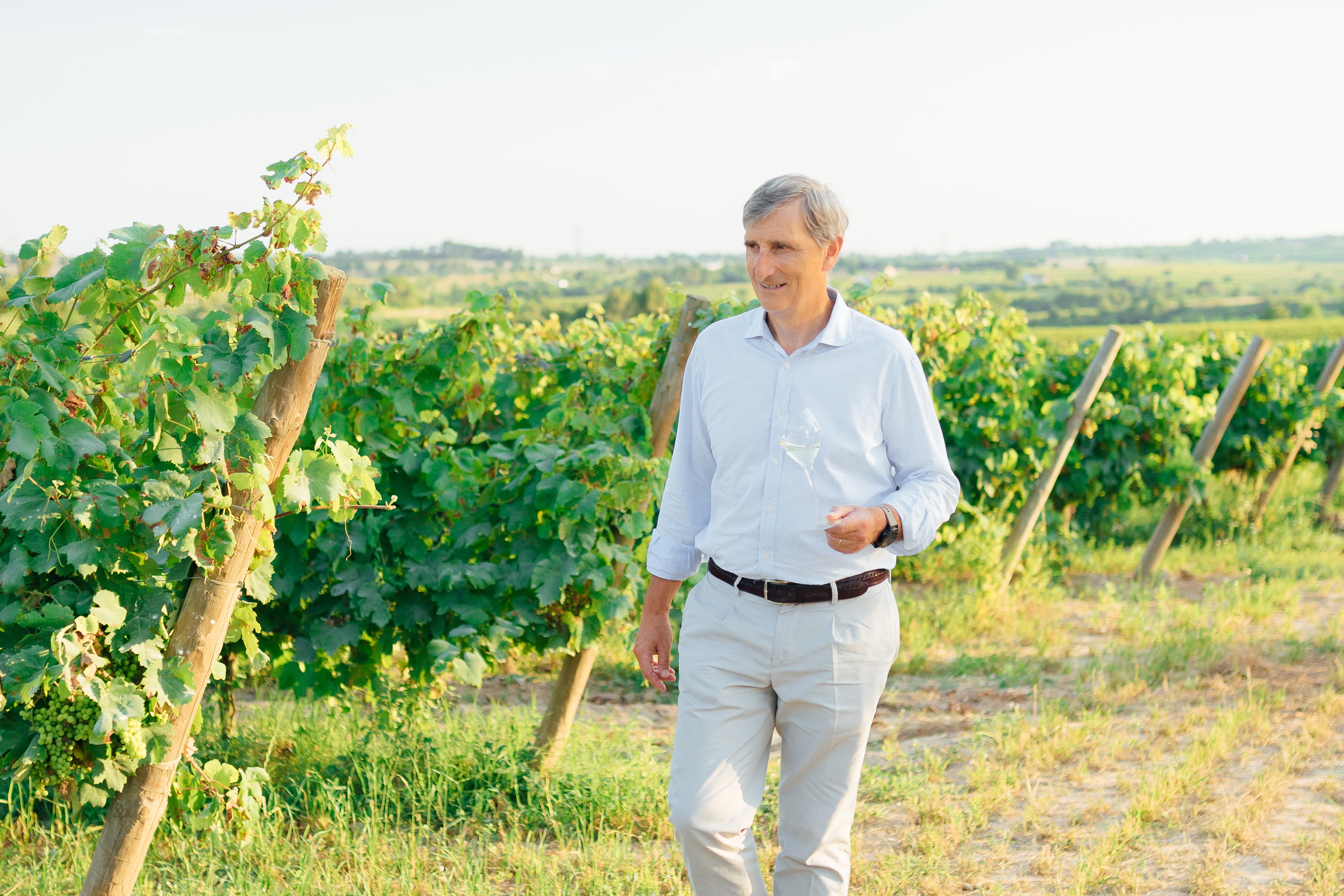According to DO Cava, the yields for Catalonia have dropped from 300 million kilos in 2021 to 230 million in 2023, with 2024 expected to be even lower. That’s a loss equivalent to around five times the total production of English wine.
DI caught up with Javier Pages, president of DO Cava, who says: “The lack of rainfall has created lots of problems, economic problems and concerns mentally in the sense that growers haven’t been getting their usual revenues because they had very low yields. Plus, the old vines have suffered and some of them have died.”
Andreas Brokemper, chief executive of Henkell Freixenet, one of the biggest cava producers in the business, adds: “Contrary to expectations, the situation of cava has not eased. In 2024 the rainfall improved but the drought affected the vineyards and the harvest was much too small to serve the global supply.
“Catalonia is still in a ‘moderate drought’ according to data from the Meteorological Service of Catalonia from September 2024, as it has not rained enough for three years, and the soil has not yet stored enough moisture. The sharp decline in the grape harvest for cava production had an impact on cava base wine that more than doubled.
“In the medium term, cava will not be able to meet global demand. This is a huge challenge that affects the entire wine sector and the entire production chain in the region: from the farmers to the cava and wine producers, the glass companies, the corks and the transport. To overcome these challenges, we think it is essential to work closely together with the politicians, authorities, the Consejo Regulador, the grape growers and the producers to find solutions to overcome these threats.”
Perelada is a member of The World’s Most Admired Wine Brands and produces a wide range of cavas. Delfí Sanahuja, director of oenology at Perelada (pictured), says: “The concern about the consecutive poor harvests for cava over the last two years is significant, as it directly affects our ability to meet sales forecasts, both nationally and internationally. The low production of the last two harvests within the Cava DO makes it difficult to achieve the targets set by the commercial department. This forces us to make adjustments in order to meet the demands of our current customers while also trying to attract new clients, without compromising the quality and authenticity of our wines.”

Clearly winemakers are worried, but Pages has a brighter outlook. “First, climate change has never been that abrupt. Things are changing, but I don’t think we can go from a normal range for the region and then all of a sudden not having any more rain forever. I doubt that happens. The second thing is that this year already, in 2024, we have had much more rain. At the end of the last harvest, once the grapes were in the houses, there was a lot of rain. So, the plants are taking most of the water for themselves rather than for the fruit this year and our expectation is that next year we might have a regular harvest. So, it looks good but there is still a long time to go.”
For small-to-medium producers, the effects of drought are more immediate than for the major players, but the overall category is under strain. Pages adds: “I’m willing to say that not all the cellars have the same kind of concerns, but some of them really were very short in terms of grapes and that means that if they couldn’t be making enough cava for their sales, they are using more inventory than there is inventory coming in.
“Exporters and distributors, if they can’t supply their demand, then they can lose a bit of faith. They know that not all the time you can supply what they want because here it’s clearly not a question of bad management, it’s a question of nature and they understand that. However, buyers will then choose different options and it cannot be possibly from cava because the shortage is already coming from cava. They therefore have to choose other sources to keep selling the same amount of sparkling wine.”
Codorníu is one of the major players in the cava sector and Diego Pinilla, chief winemaking & operations officer at Raventós Codorníu, believes the lack of rain is not just a problem for cava production, but quality too.
“It’s important to note that reduced water is not always a synonym for better quality. No, you always have to have a balance in the vine. Often with red wines, lower yields lead to better wines, but with whites it’s not so much the case.
“We cannot say because the weather is getting drier, we are going to have better quality. In fact, we could end up with lower yields with less quality.”
GUARANTEED QUALITY
Fortunately for Codorníu, one of its sister wineries, Raimat in Lleida, has enjoyed a period of excellence in both quality and quantity in recent years, providing a significant proportion of Codorníu’s production. The success of Raimat’s wines has guaranteed the quality of Codorníu but the company is working hard on solutions for the future, such as five-year contracts with its winegrowers and potential solutions to water shortages.
Peralada’s Sanahuja adds: “Finding sustainable irrigation techniques will be crucial and identifying responsible water resources will be a key challenge. It’s not about producing more grapes, but ensuring the survival of the vines, stabilising quality and ensuring more consistent harvests. This will allow us to minimise the effects of rainfall variability and improve profitability without compromising quality.
“We work with grape varieties that have longer cycles and are more resistant to drought, which allows them to better adapt to the current climate.
“Additionally, we have intensified our efforts to manage precipitation scarcity by applying sustainable practices and optimising water consumption, including the implementation of regenerative irrigation systems.”
Codorníu head winemaker Bruno Colomer told Drinks International during a recent visit about the potential of its longer-ageing cava. “We are the only company to produce 100% Parellada and traditionally everyone in Spain says Parellada is not made for ageing. But we are thinking we can produce a special blend with Parellada because there are some with more than 10 years and it’s incredible. It’s so fresh.
“For us the most important thing is to avoid the oxidation of the base wines. We have learned this year that clarification is better done by flotation than static settling, because we have oxidation and if you oxidate the wine after fermentation, your wine is more consistent and you can age for 10 years.”
As well as producing some older aged cava, Colomer has played around with other techniques. During a tasting at the winery late last year, he produced a Xarello 2017, which saw the first fermentation take place in brandy de Jerez barrels. He also has a variety of different shaped stainless steel tanks to play around with throughout 2025.
Pinilla adds: “I don’t think we will change our style in reaction to the droughts. For sure, we are interested in longer aged wines as an expression, but not all our cava will be ageing longer because the weather is warming. We can have a small range of cava for experimentation. The learning with the brandy expression was also to learn how ageing the wine in oak affects the flavour, and we’re doing lots of different experiments like this.”
While irrigation solutions and adopting new grape varieties could help future-proof cava, DO Cava president Pages (pictured below) has a new insurance policy called Provision of Qualified Guaranteed, which sees entry level cava (guarda) allowed to build reserve wines.

“Cava needs to secure enough grape supply for growth and create flexibility and reserves to overcome periods of drought, which for sure will happen more often and become longer due to climate extremes,” he says.
Under the regulation, wineries can stock extra wines for up to three years in order to supply demand even in years of drought. “It’s an instrument where we can, hopefully, in good years build up reserves. And then, at the end of the year, we will look into the sales and inventory level and according to that ratio we’ll decide altogether if some reserve wines will be released for cava production. But once they are agreed to be released, the DO examines those wines and if they pass the examination they will become cava wines on top of the ones they had at the harvest. We want to build that reserve of about three years because a wine cannot be in that reserve longer than three years. This system is also good for winegrowers, because they will be paid for producing more grapes for the reserves, guaranteeing them a more sustainable economic future.”
It’s often argued by its fans that cava is undervalued compared to other European sparkling wines, but according to Pages one of the potential repercussions of the recent droughts is a revaluation of the category. Pages adds: “The demand has kept high, but not the offering. We’ll be seeing that for this year and obviously next year. It will take a little time to recover those sales, because again, maybe some of the prices cava was selling for before, we may never see them again. Usually, when you cannot supply to your customers the amount of wine they want, you end up losing some of it. But at the same time, the value of the whole thing usually goes up as well. We are clearly overdelivering in terms of quality, so I think it’s only normal that cava, generally speaking, revalues itself.”




